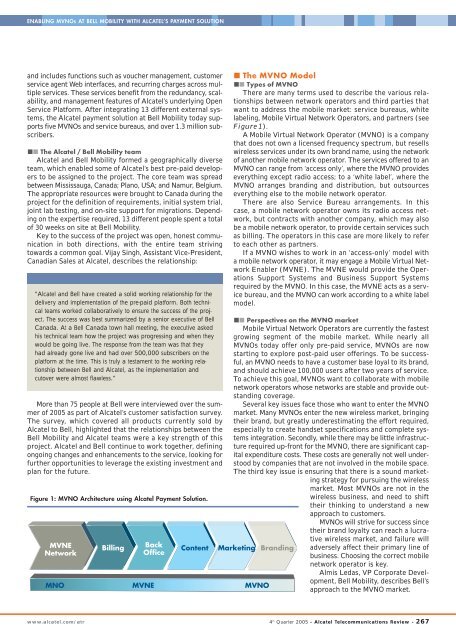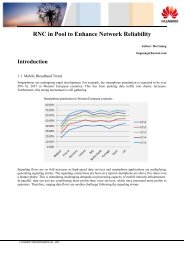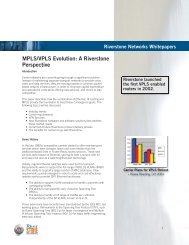report - Light Reading
report - Light Reading
report - Light Reading
Create successful ePaper yourself
Turn your PDF publications into a flip-book with our unique Google optimized e-Paper software.
ENABLING MVNOs AT BELL MOBILITY WITH ALCATEL’S PAYMENT SOLUTION<br />
and includes functions such as voucher management, customer<br />
service agent Web interfaces, and recurring charges across multiple<br />
services. These services benefit from the redundancy, scalability,<br />
and management features of Alcatel’s underlying Open<br />
Service Platform. After integrating 13 different external systems,<br />
the Alcatel payment solution at Bell Mobility today supports<br />
five MVNOs and service bureaus, and over 1.3 million subscribers.<br />
The Alcatel / Bell Mobility team<br />
Alcatel and Bell Mobility formed a geographically diverse<br />
team, which enabled some of Alcatel’s best pre-paid developers<br />
to be assigned to the project. The core team was spread<br />
between Mississauga, Canada; Plano, USA; and Namur, Belgium.<br />
The appropriate resources were brought to Canada during the<br />
project for the definition of requirements, initial system trial,<br />
joint lab testing, and on-site support for migrations. Depending<br />
on the expertise required, 13 different people spent a total<br />
of 30 weeks on site at Bell Mobility.<br />
Key to the success of the project was open, honest communication<br />
in both directions, with the entire team striving<br />
towards a common goal. Vijay Singh, Assistant Vice-President,<br />
Canadian Sales at Alcatel, describes the relationship:<br />
“Alcatel and Bell have created a solid working relationship for the<br />
delivery and implementation of the pre-paid platform. Both technical<br />
teams worked collaboratively to ensure the success of the project.<br />
The success was best summarized by a senior executive of Bell<br />
Canada. At a Bell Canada town hall meeting, the executive asked<br />
his technical team how the project was progressing and when they<br />
would be going live. The response from the team was that they<br />
had already gone live and had over 500,000 subscribers on the<br />
platform at the time. This is truly a testament to the working relationship<br />
between Bell and Alcatel, as the implementation and<br />
cutover were almost flawless.”<br />
More than 75 people at Bell were interviewed over the summer<br />
of 2005 as part of Alcatel’s customer satisfaction survey.<br />
The survey, which covered all products currently sold by<br />
Alcatel to Bell, highlighted that the relationships between the<br />
Bell Mobility and Alcatel teams were a key strength of this<br />
project. Alcatel and Bell continue to work together, defining<br />
ongoing changes and enhancements to the service, looking for<br />
further opportunities to leverage the existing investment and<br />
plan for the future.<br />
Figure 1: MVNO Architecture using Alcatel Payment Solution.<br />
MVNE<br />
Network<br />
Billing<br />
Back<br />
Office<br />
Content<br />
MNO MVNE MVNO<br />
The MVNO Model<br />
Types of MVNO<br />
There are many terms used to describe the various relationships<br />
between network operators and third parties that<br />
want to address the mobile market: service bureaus, white<br />
labeling, Mobile Virtual Network Operators, and partners (see<br />
Figure 1).<br />
A Mobile Virtual Network Operator (MVNO) is a company<br />
that does not own a licensed frequency spectrum, but resells<br />
wireless services under its own brand name, using the network<br />
of another mobile network operator. The services offered to an<br />
MVNO can range from ‘access only’, where the MVNO provides<br />
everything except radio access; to a ‘white label’, where the<br />
MVNO arranges branding and distribution, but outsources<br />
everything else to the mobile network operator.<br />
There are also Service Bureau arrangements. In this<br />
case, a mobile network operator owns its radio access network,<br />
but contracts with another company, which may also<br />
be a mobile network operator, to provide certain services such<br />
as billing. The operators in this case are more likely to refer<br />
to each other as partners.<br />
If a MVNO wishes to work in an ‘access-only’ model with<br />
a mobile network operator, it may engage a Mobile Virtual Network<br />
Enabler (MVNE). The MVNE would provide the Operations<br />
Support Systems and Business Support Systems<br />
required by the MVNO. In this case, the MVNE acts as a service<br />
bureau, and the MVNO can work according to a white label<br />
model.<br />
Perspectives on the MVNO market<br />
Mobile Virtual Network Operators are currently the fastest<br />
growing segment of the mobile market. While nearly all<br />
MVNOs today offer only pre-paid service, MVNOs are now<br />
starting to explore post-paid user offerings. To be successful,<br />
an MVNO needs to have a customer base loyal to its brand,<br />
and should achieve 100,000 users after two years of service.<br />
To achieve this goal, MVNOs want to collaborate with mobile<br />
network operators whose networks are stable and provide outstanding<br />
coverage.<br />
Several key issues face those who want to enter the MVNO<br />
market. Many MVNOs enter the new wireless market, bringing<br />
their brand, but greatly underestimating the effort required,<br />
especially to create handset specifications and complete systems<br />
integration. Secondly, while there may be little infrastructure<br />
required up-front for the MVNO, there are significant capital<br />
expenditure costs. These costs are generally not well understood<br />
by companies that are not involved in the mobile space.<br />
The third key issue is ensuring that there is a sound marketing<br />
strategy for pursuing the wireless<br />
market. Most MVNOs are not in the<br />
wireless business, and need to shift<br />
their thinking to understand a new<br />
approach to customers.<br />
MVNOs will strive for success since<br />
their brand loyalty can reach a lucrative<br />
wireless market, and failure will<br />
Marketing Branding adversely affect their primary line of<br />
business. Choosing the correct mobile<br />
network operator is key.<br />
Almis Ledas, VP Corporate Development,<br />
Bell Mobility, describes Bell’s<br />
approach to the MVNO market.<br />
www.alcatel.com/atr 4 th Quarter 2005 - Alcatel Telecommunications Review - 267
















